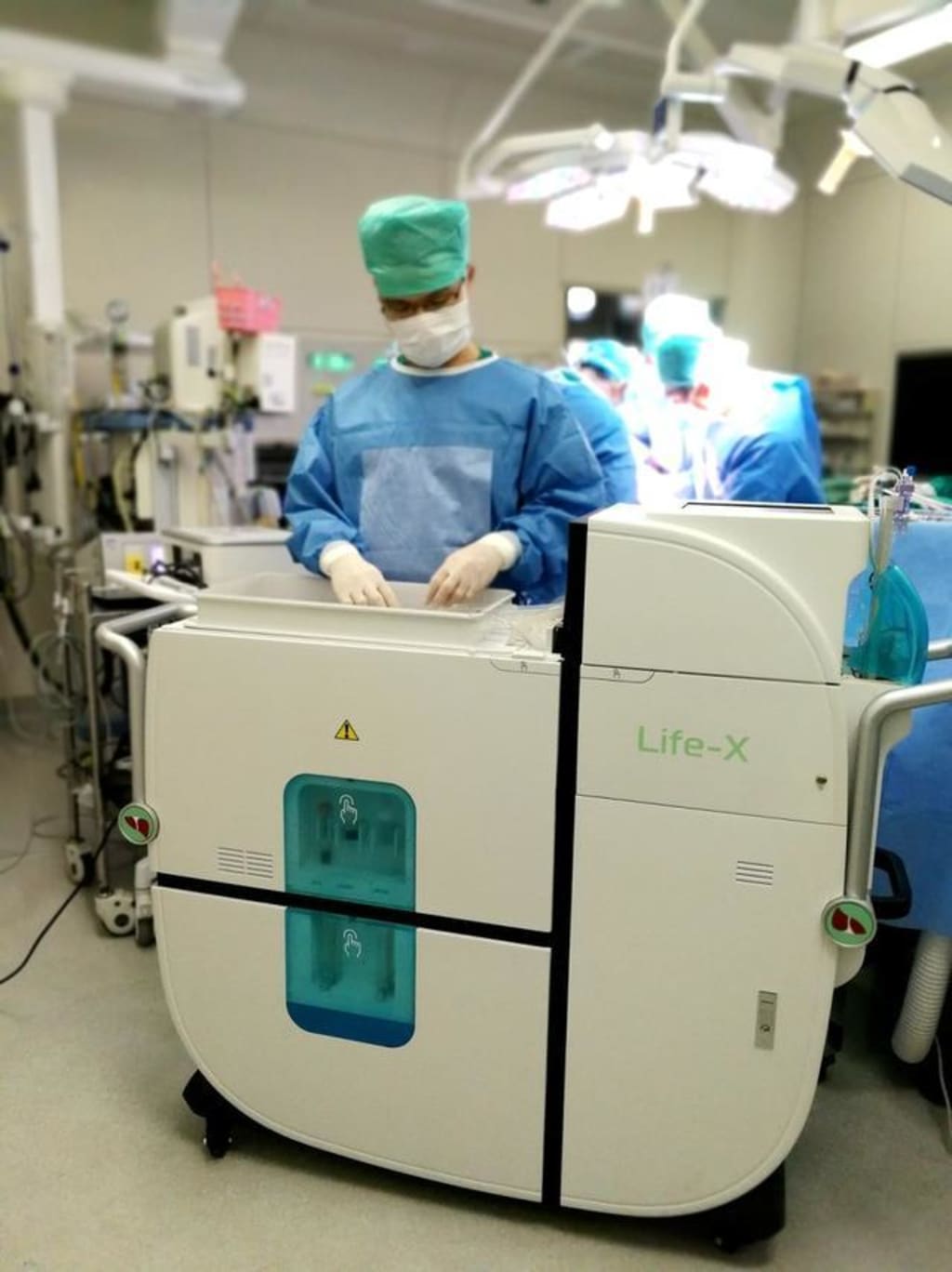Transformation of Organ Transplantation: It took them 8 years to bring organ transplantation into an era of no ischemia in the whole process
Let organ transplantation enter the era of ischemia-free throughout the process

Organ transplantation, known as a great technology with epoch-making significance in the field of biomedicine in the 20th century, is a new medical model for human beings to change traditional treatment methods and save lives for patients with various organ failures. The author called "organ transplantation a miracle of the twentieth century" that revolutionized the field of medicine.
"Organ transplantation can be said to be the most precious gift brought to people by the development of science and technology. It is often used as a last resort for the treatment of various end-stage diseases, but in fact, there have always been problems in organ transplantation technology. One factor is the ischemic injury during organ transplantation." He Xiaoshun, vice president of the First Affiliated Hospital of Sun Yat-sen University and head of the Department of Organ Transplantation Science, told the Health Times reporter.
Helplessness in great technology: Most of the side effects of organ transplants are related to it
Organ transplantation refers to the operation of transplanting a viable organ of another person to a patient to replace the damaged organ by surgical means. In 1954, the world's first successful kidney transplant opened up a new era of organ transplantation. According to the latest data from the China Human Organ Donation Management Center, as of April 25, 2020, 28,643 organ donation surgeries have been performed in my country, and 83,006 organs have been donated.
"In 2017, I had a patient with liver failure. When his life was counting down, he finally got a liver donor who was very good in all aspects. A young man fell from a height and died, and he was willing to donate his liver. , we immediately performed a liver transplant for him." He Xiaoshun recalled that during our operation, we found that the liver was in very good condition, and the transplant process was very smooth, but when the operation was about to end, an accident happened. The abdominal cavity began to ooze blood, and everyone panicked at that time, because the quality of the organs and the operation seemed to be very good.
Under the existing technical system of organ transplantation, organs are obtained from donors and transplanted to patients, which need to experience long-term interruption of blood supply, and organ ischemia damage is inevitable. This drawback basically runs through organ acquisition, preservation and implantation. the whole process. He Xiaoshun said, "This should be the root cause of the high risk of transplant surgery. We later analyzed that the operation in 2017 should also be related to this."
"Imagine that an organ that has been kept in ice for a period of time needs to fit well with the recipient immediately after the transplant operation, which must be a big shock to the recipient's other organs." Sun Yat-Sen University Zhao Qiang, deputy chief physician of the Organ Transplantation Department of the First Affiliated Hospital, told the Health Times reporter that the previous organ transplantation technology would be affected by this drawback to some extent.
He Xiaoshun introduced, "Organ ischemia-reperfusion injury is the main reason affecting the prognosis of transplantation, which can lead to postoperative primary graft non-function (incidence 6%), early graft insufficiency (incidence 43.8%), lack of Blood type biliary tract disease (incidence 9%) and post-reflow syndrome (incidence 53.6%), the one-year survival rate of patients is only 84.6%."
Adding weight to greatness: 8 years to bring organ transplantation into the era of ischemia-free
"Any organ is the best gift that his provider leaves the world after he leaves the world. As a doctor, we must make this gift more valuable." He Xiaoshun said, so we are thinking, if we can do it without The whole process of transplantation is completed in the state of interrupting the blood flow of the organ, so that the problem of organ ischemia will not be overcome.
Since 2012, He Xiaoshun and his team have tried to solve this problem. "The essence of organ ischemia injury is organ ischemia, so the first thing we need to solve is the ischemia problem after the organ is isolated from the body." He Xiaoshun told reporters, according to Therefore, we have invented the world's first in vitro multi-organ repair system, creating perfusion pressure, temperature, oxygenation and physiological support for isolated organs that are close to in vivo physiological conditions.
Based on this, He Xiaoshun put forward a bold hypothesis, based on the multi-organ repair system, whether organ transplantation can be completed without interrupting the blood flow of the organ. "The organ transplantation process inevitably involves the severing and re-anastomosing of the blood vessels entering and exiting the organ. How to ensure that the blood flow is not interrupted every second during this complex process?" This has become another major challenge for He Xiaoshun and his team. In this way, they designed a new set of organ transplantation procedures after many meetings and experiments, which they named "ischemia-free organ transplantation".
In order to complete this new surgical technique, they have completed nearly 100 large animal experiments. "The big animals we chose at that time were mainly pigs, because it was summer, and all these experiments had to be done in our laboratory. At that time, the smell was very strong and there were a lot of mosquitoes, but everyone still completed these things overnight." Zhao Qiang recalled.
"There are many difficulties in the whole process. Our research must be cross-industry, we need to cooperate with engineers, we must also solve many problems that we are concerned about, we must also formulate judgment standards, and even we must pay attention to some industrialization aspects." Zhao Qiang told Reporter, it's worth it. Our 30 researchers spent 8 years together to accomplish such a thing.
82 cases have been completed in 3 years! Significant improvement in organ utilization and recipient survival
After completing more than 100 large animal trials, He Xiaoshun and his team performed surgery on a patient with liver cirrhosis and small liver cancer on July 23, 2017, completing the world's first "ischemia-free" liver transplant.
"The patient was hospitalized in our hospital at the time. After we evaluated his basic condition, we decided to use ischemia-free transplantation for his liver transplant. Because it was the first case, we made a very comprehensive evaluation before surgery, taking into account all the In the event of a possible accident, all the experts from our hospital's anesthesiology department, intensive care department and many other departments are on standby in the operating room." Zhao Qiang recalled that after everything was arranged, the operation began.
The liver organ was donated to this patient by a young man in his 20s. The preoperative evaluation of the liver organ was very good, but when He Xiaoshun and Zhao Qiang took out his liver, an accident happened, "We found out that the liver was in good condition. The donor is a patient with extremely severe fatty liver. If the traditional liver transplantation is performed, the liver will definitely be unusable, because fatty liver is more sensitive to ischemic damage." Zhao Qiang told reporters, but it is precisely because of this lack of use. Ischemia transplantation, the liver can be successfully transplanted into the recipient.
"The whole operation went very smoothly. There was no reflow syndrome after liver reflow after operation. The patient's blood lactate level returned to normal one hour after reflow, and the patient was awake two hours after operation. The injury index was significantly lower than that of conventional liver transplant recipients, and the patient was discharged smoothly on the 18th day." Zhao Qiang said that at present, the patient's recovery status is also very good, and postoperative complications are also significantly lower than those of ordinary liver transplant patients. The family has thanked us many times.
According to a reporter from Health Times, 82 cases of the world's first ischemia-free liver transplantation have been performed. After ischemia-free transplantation, aspartate aminotransferase has been reduced by 74.4% compared with traditional techniques, and primary graft non-function (PNF) has been reduced from 6%. To 0, early graft insufficiency decreased from 53% to 3.3%, greatly reducing the risk of surgery. Because ischemic injury is avoided, ischemia-free organ transplantation techniques can maximize the efficacy of transplantation and increase the utilization of transplanted organs.
Recently, the "Ischemia-Free Organ Transplantation" project won the special prize of the 2020 International Quality Innovation Competition, which is also the first time my country has won this award. Zhao Qiang said, "At present, we are working on the promotion of this technology, and we believe that in the near future, this technology will be gradually applied to more organ transplants. The love is transplanted into the recipient in the best condition."
About the Creator
dardani lennon
The question mark is the key to any science
Enjoyed the story? Support the Creator.
Subscribe for free to receive all their stories in your feed. You could also pledge your support or give them a one-off tip, letting them know you appreciate their work.






Comments
There are no comments for this story
Be the first to respond and start the conversation.